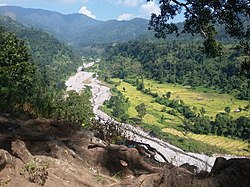A | B | C | D | E | F | G | H | CH | I | J | K | L | M | N | O | P | Q | R | S | T | U | V | W | X | Y | Z | 0 | 1 | 2 | 3 | 4 | 5 | 6 | 7 | 8 | 9
This article has multiple issues. Please help improve it or discuss these issues on the talk page. (Learn how and when to remove these template messages)
|
Jhapa District
झापा जिल्ला | |
|---|---|
 View of both hills and Terai in Jhapa district | |
 | |
| Country | |
| Province | Province No. 1 |
| Admin HQ. | Bhadrapur |
| Government | |
| • Type | Coordination committee |
| • Body | DCC, Jhapa |
| • Head | Mr. Somnath Bishwakarma |
| • Deputy-Head | Mrs. Mina Parajuli |
| • Parliamentary constituencies | 5 |
| • Provincial constituencies | 10 |
| • Chief District Officer | Chhabilal Rijal [1] |
| Area | |
| • Total | 1,606 km2 (620 sq mi) |
| Elevation (maximum) | 506 m (1,660 ft) |
| Population (2021) | |
| • Total | 994,090 |
| • Rank | 4th (Nepal) |
| • Density | 620/km2 (1,600/sq mi) |
| • Households | 219,989 |
| Demographics | |
| • Ethnic groups | Bahun, Chhetri, Rajbanshi, Limbu, Rai |
| • Female ♀ | 51.97% |
| • Male ♂/100 female | 92,43 |
| Human Development Index | |
| • Per Capita Income | 1,226 USD |
| • Poverty rate | 21.82 |
| • Literacy | 75 % |
| • Life Expectancy | 67.29 |
| Time zone | UTC+05:45 (NPT) |
| Telephone Code | 023 |
| Main Language(s) | Nepali, Rajbanshi, Limbu, Maithili |
| Major highways | Mahendra Highway, Postal Highway |
| Website | daojhapa |
Jhapa (Nepali: झापा जिल्ला; ![]() Listen (help·info)) is a district of Province No. 1 in eastern Nepal named after a Rajbanshi word "Jhapa" meaning "to cover" (verb). The latest official data, the 2021 Nepal Census, puts the total population of the district at 994,090.[3] The total area of the district is 1,606 square kilometres.
Listen (help·info)) is a district of Province No. 1 in eastern Nepal named after a Rajbanshi word "Jhapa" meaning "to cover" (verb). The latest official data, the 2021 Nepal Census, puts the total population of the district at 994,090.[3] The total area of the district is 1,606 square kilometres.
Location
Jhapa is the easternmost district of Nepal and lies in the fertile Terai plains. It is part of the Outer Terai. Jhapa borders with Ilam in the north, Morang in the west, the Indian state of Bihar in the south and the Indian state of West Bengal to the southeast and east. Geographically, it covers an area of 1,606 km2 (620 sq mi) and lies on 87°39’ east to 88°12’ east longitude and 26°20’ north to 26°50’ north latitude.[4]
Climate and geography
Jhapa receives 250 to 300 cm of rainfall a year, and mostly during the monsoon season in the summer, and its hilly northern area receives more rainfall than the south.[5] The maximum temperature recorded is 42 °C in summer and 10 °C in winter. The lowest elevation point is 58 meters which is the lowest land in Nepal and the highest elevation point is 500 meters from mean sea level.[4]
| Climate Zone[6] | Elevation Range | % of Area |
|---|---|---|
| Lower Tropical | below 300 meters (1,000 ft) | 98.8% |
| Upper Tropical | 300 to 1,000 meters 1,000 to 3,300 ft. |
1.2% |
Administrative Division
Jhapa consists of 15 administrative divisions including 8 municipalities and 7 rural municipalities. Each divisions have wards according to the demographic and geographic size. These are:
Municipalities
- Mechinagar Municipality
- Bhadrapur Municipality
- Birtamod Municipality
- Arjundhara Municipality
- Kankai Municipality
- Shivasatakshi Municipality
- Gauradaha Municipality
- Damak Municipality
Rural Municipalities
- Buddhashanti Rural Municipality
- Haldibari Rural Municipality
- Kachankawal Rural Municipality
- Barhadashi Rural Municipality
- Jhapa Rural Municipality
- Gauriganj Rural Municipality
- Kamal Rural Municipality
Demographics
Jhapa district has average population density of around 619 per square kilometer. The district population growth rate is 1.93%. However, the growth is balanced and in-migration is rapidly increasing day to day into the district. At the time of the 2021 Nepal census, Jhapa District had a population of 994,090 making it the 4th largest district in Nepal after Kathmandu, Morang and Rupandehi.
Being at the cross-roads of the eastern hills and the eastern Terai, Jhapa has huge ethnic diversity with 110 castes/ethnic groups represented. The largest communities are Bahun and Chhetri . Other communities include the Janajati Limbu and other Kirati peoples, Dalit communities like Kami and Damai, as well as Tamang, Newar and Magar and Adivasi communities like the Rajbanshi/Tajpuriya, Gangai, Santal and Dhimal in the Terai.
| Rank | Language | Speakers | Percentage |
|---|---|---|---|
| 1 | Nepali (lingua franca) | 453,536 | 55.82% |
| 2 | Rajbanshi/Tajpuria | 95,331 | 11.73% |
| 3 | Limbu | 45,484 | 5.60% |
| 4 | Maithili | 45,038 | 5.54% |
| 5 | Santali | 29,464 | 3.63% |
| 6 | Rai | 20,665 | 2.54% |
| 7 | Urdu | 19,796 | 2.44% |
| 8 | Tamang | 17,218 | 2.12% |
| 9 | Newari | 11,992 | 1.48% |
| 10 | Magar | 10,203 | 1.26% |
| 11 | Dhimal | 8,123 | 1.0% |
International Borders
Jhapa borders the Indian state of Bihar to the south and the Indian state of West Bengal to the east. Jhapa is an eastern entry point of Nepal from India. Kakarbhitta-Mechinagar border lies in Jhapa and is an important trade point for Nepal.
Education
Among 77 districts, Jhapa has a literacy rate of 75.2%, higher than the national average.[8] There are enough primary schools, secondary schools, high schools and colleges available both from private sector and the government.
Notable people
Jhapa district is home to notable personalities including one former prime minister and two former deputy prime ministers.
- KP Sharma Oli, former prime minister of Nepal and chairman of CPN (UML)
- Bishwa Prakash Sharma, general secretary of Nepali Congress
- Rajendra Prasad Lingden, chairman of Rastriya Prajatantra Party
- Krishna Prasad Sitaula, former Home minister and senior leader of Nepali Congress
- Radha Krishna Mainali, senior Communist leader
- CP Mainali, chairman of CPN (ML) and former Deputy prime minister of Nepal
- Ananta Tamang, National Football Player, All Nepal Football Association
References
- ^ "Staff Profile of DAO". The Government of Nepal. Retrieved 23 November 2022.
- ^ "Nepal Human Development Report 2014". Npc.gov.np. Retrieved 2022-04-11.
- ^ "Preliminary Report of National Population Census 2021". National Census 2021. National Statistical Office. Retrieved 6 December 2022.
- ^ a b District Transport Masterplan-Jhapa (PDF), retrieved May 5, 2020
- ^ Climate in Jhapa, retrieved May 5, 2020
- ^ The Map of Potential Vegetation of Nepal - a forestry/agroecological/biodiversity classification system (PDF), Forest & Landscape Development and Environment Series 2-2005 and CFC-TIS Document Series No.110., 2005, ISBN 87-7903-210-9, retrieved Nov 22, 2013
- ^ "National Data Portal-Nepal". nationaldata.gov.np. Retrieved 2020-06-29.
- ^ "Census 2001". Census. central bureau of statistics, Nepal. 2001. Archived from the original on 2008-09-24. Retrieved 2008-08-24.
External links
- "Districts of Nepal". Statoids.
Coordinates: 27°55′03″N 84°11′37″E / 27.917373°N 84.193726°E
>Text je dostupný pod licencí Creative Commons Uveďte autora – Zachovejte licenci, případně za dalších podmínek. Podrobnosti naleznete na stránce Podmínky užití.
Šátek
Beadweaving
Bižuterie
Bolo
Dřevěný motýlek
Deštník
Digitálky
Faléra
Fiží
Text je dostupný za podmienok Creative
Commons Attribution/Share-Alike License 3.0 Unported; prípadne za ďalších
podmienok.
Podrobnejšie informácie nájdete na stránke Podmienky
použitia.


